Smoked Pulled Pork: Delicious Results in Almost Half the Time
Who doesn’t love tender, juicy, melt-in-your-mouth, smoked pulled pork? But traditional cook times for this BBQ staple can have you up in the wee hours of the morning checking your smoker. Thanks to accurate temperature tools and careful monitoring of the temperature of both the smoker and the meat inside it, we were able to cut 7 hours off of traditional smoking times while preserving all of the flavor and most of the moisture and silky texture.
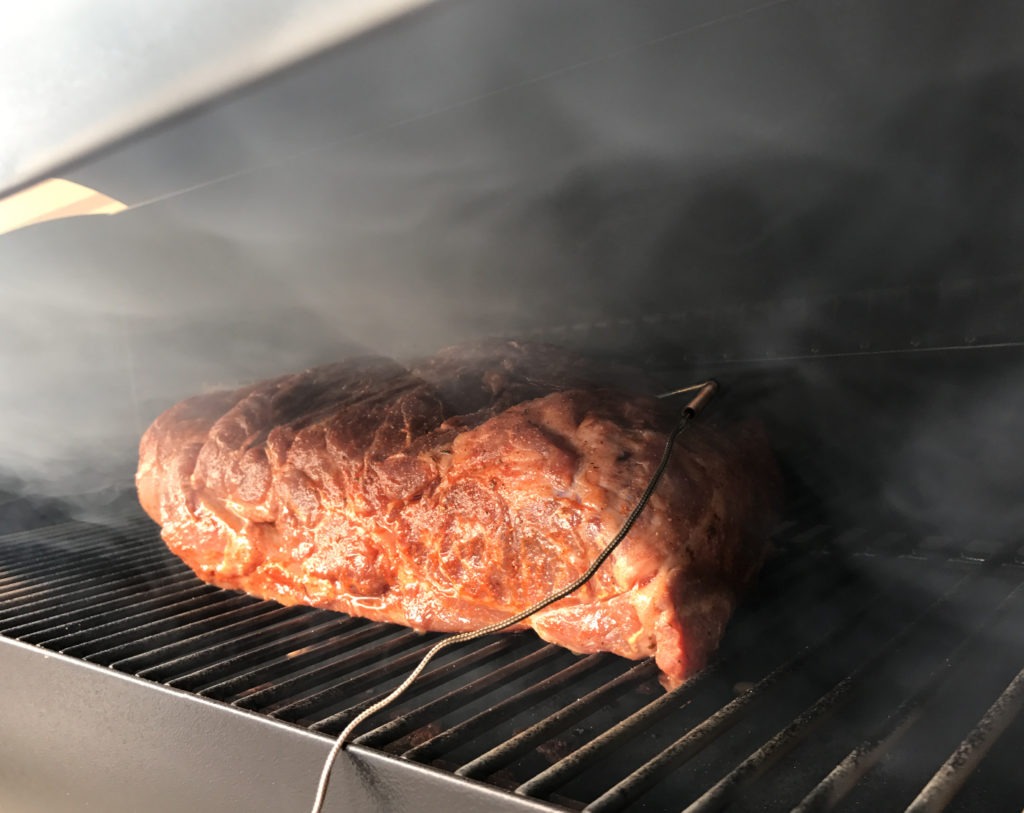
Pork Butt Pull Temp: 195–200°F
(By the way, if you’re interested in a Kansas City-style treat, check out our post on making sliced BBQ pork shoulder.)
History: Why is it Called a Pork Butt?
Pulled pork comes from the pork butt, but where does that name come from, anyway?
The cut is nowhere near the hog’s rear end (the anatomical “butt” of the animal is actually the ham)—the pork butt is a sub-primal cut from the pork shoulder. The name, it turns out, comes from the name of a barrel.
In the early nineteenth century, New England was a pork-production powerhouse. The shoulder was the least desirable cut and was routinely packed into wooden barrels and shipped out across the country for processing. Barrels came in different sizes (the hogshead, the tierce), but the ones pork shoulders were packed into were of the size officially known as the “butt.” These 126-gallon (477-liter) barrels filled with pork came to be known as “Boston Butts,” a term that was soon applied to the meat inside.
Pork Butt Temperatures:
But let’s get back to the matter at hand: making great pulled pork. The USDA recommends that pork is cooked to an internal temperature of 145°F (62.8°C) for food safety. But every pit-boss worth their salt knows that cuts rich in collagen, like pork butt, need to be brought to much higher temperatures (195-205°F [91-96°C]) to properly break down the connective tissues. What’s more, dissolving the collagen into gelatin and successfully rendering the fat usually requires lower sustained temperatures during the cook than do turkeys or roasts. This is what gives the resulting pulled pork meat its signature moist and silky texture.
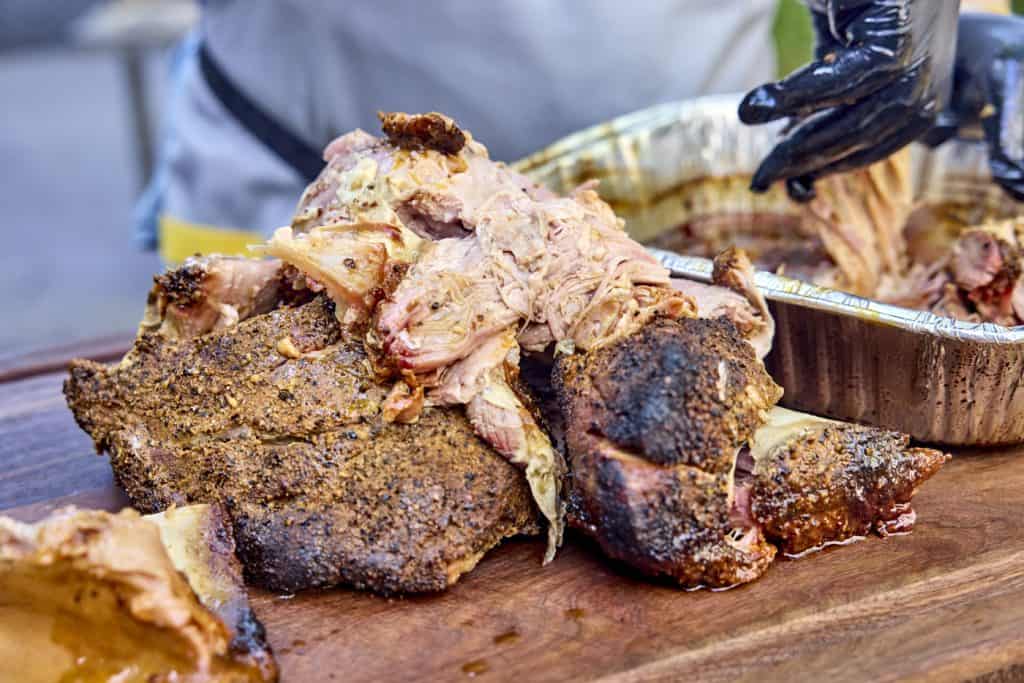
The art of smoking meat is all about taking tough cuts of meat such as pork shoulder and brisket and turning them into tender, juicy, flavorful masterpieces by controlling low cooking temperatures over time.
Why Low and Slow?
The anatomy of this cut is what determines its optimal cooking method. It is a heavily-worked muscle on the animal, and because of the load-bearing activity of the shoulder muscle, the protein fibers are held together with a tough web of connective tissue. Though the butt starts tough, those who take the time and effort to tenderize it are amply rewarded with a deep, rich flavor and a succulent texture.
Pork shoulder is the lead of culinary alchemists, just waiting, itching to be turned into gold.
—The Food Lab, J. Kenji Lopez-Alt
“The Most Traditional Method” typically recommends keeping the internal air temperature of your smoker at about 225°F (107°C) during the cook. But at that temperature, it can take as long as 18 hours to bring the internal temperature of the pork up to its target of 195-205°F (91-96°C).
But is it possible to achieve similar results with a higher smoker temp?

Cooking pulled pork faster
Rather than cooking our pork butt at 225°F (107°C) and leaving it unwrapped the whole time—strictly speaking, the most “traditional” method—you can get almost identical, but much faster, results by turning up the heat and wrapping your pork. To demonstrate, we took a bone-in pork butt and cooked it with our RFX Starter Kit to see how long it would take.
Setting up the smoker
After seasoning the pork butt well, we inserted our RFX MEAT wireless probe up to the recommended immersion line, angling the probe so that the four sensors would be in the vicinity of the center of the meat. We attached RFX GATEWAY to our Billows BBQ Control Fan and preheated our kamado-style cooker to 300°F (149°C) with the included air probe checking the temps. Then we put the pork butt in the smoker with the deflector plate in place.
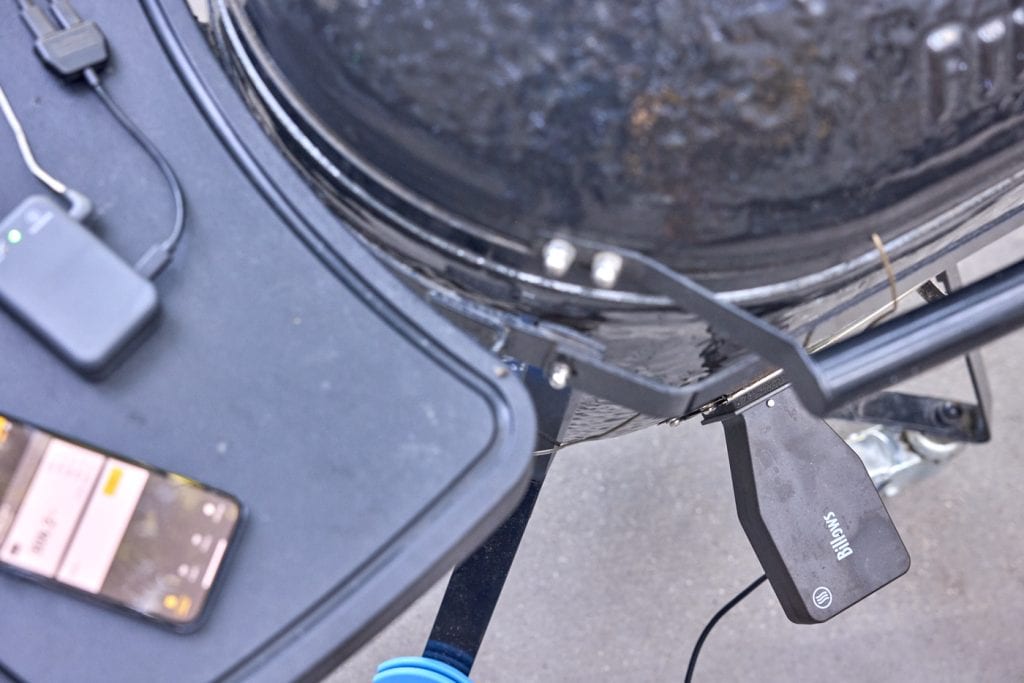
First phase of smoking
We knew we were going to wrap the meat eventually (more on that in a minute), but we didn’t want to wrap too soon, or we’d compromise bark formation. Experience and tradition both have taught us that by the time we approach the stall, the bark ought to be well set. So we set the high-temp alarm to 160°F (71°C). We knew that the bark would almost certainly be set by that temp, so we put that in as an outer-limit for checking the progress.
Probe Placement: The probe for the meat was placed with the tip in the center of the butt. Any piece of meat is only as tender as its toughest part, so we needed to make sure the thermal center of each cut was reaching our desired temperature.
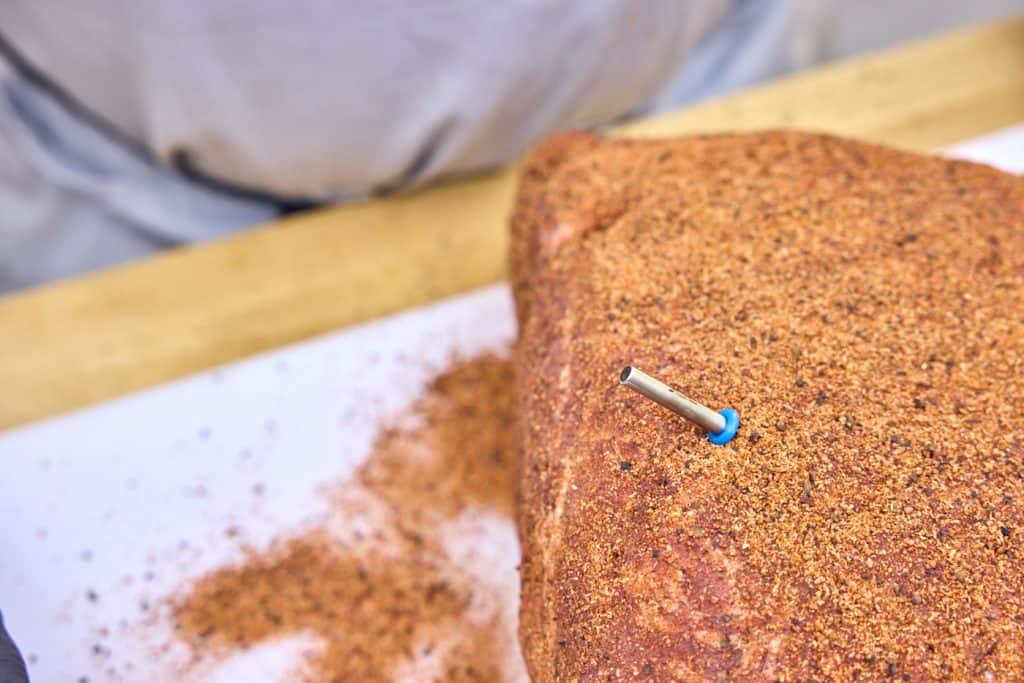
Wrapping the pork butt, overcoming the stall
Even with careful attention to smoker temps, any piece of BBQ meat will still experience “the stall.” When you smoke these collagen-rich cuts, the internal temperature of the meat will eventually plateau—or stall—at around 160°F (71°C). In fact, it can even drop slightly.
Aaron Franklin explains it well:
The stall happens as a result of something called “evaporative cooling.” It’s the same mechanism that allows sweat to cool down the body. Sweat works like this: when moisture sits on the surface of the skin, it’s evaporated by heat energy given off by the body. So when the water changes from liquid to gas form, it absorbs a significant amount of heat energy…creating a cooling effect…. Inside a cooker, the piece of meat is sort of sweating too. It’s losing moisture to the air in the form of evaporation. Interestingly, air turbulence and humidity has a greater impact on evaporation than actual temperature—and since there’s a huge amount of air movement in a smoker, the evaporation is quite significant.
–Aaron Franklin, Franklin Barbecue: A Meat-Smoking Manifesto
If you’re cooking “traditional style,” you have to practice patience when you hit the stall. It takes time for the evaporative cooling to run its course and the temperature to begin rising again, melting the collagen into gelatin. But we don’t want to practice that much patience! So we keep the higher smoker temp we were at already, but wrap the pork when we start to reach the stall. (In this case, we checked the bark at about 155°F and found it sufficiently set to wrap. Give the surface a light scratch and see whether the bark feels well-attached to the meat or if it scratches off easily.)
For extra flavor, we didn’t just wrap the butt in foil; we put it in a foil pan and added a mixture of butter, apple juice, and vinegary hot sauce—all preheated to a boil, for thermal and time reasons. then we covered the top of the pan with more foil, crimped it together, and put it back in the smoker. Our RFX MEAT had no problem communicating through the foil and the walls of the kamado, so we continued to use it to monitor the temperature of the meat as we kept cooking. Of course, we changed our high-temperature alarm at that point, aiming for 203°F (95°C)—which was easily done in the free ThermoWorks App.
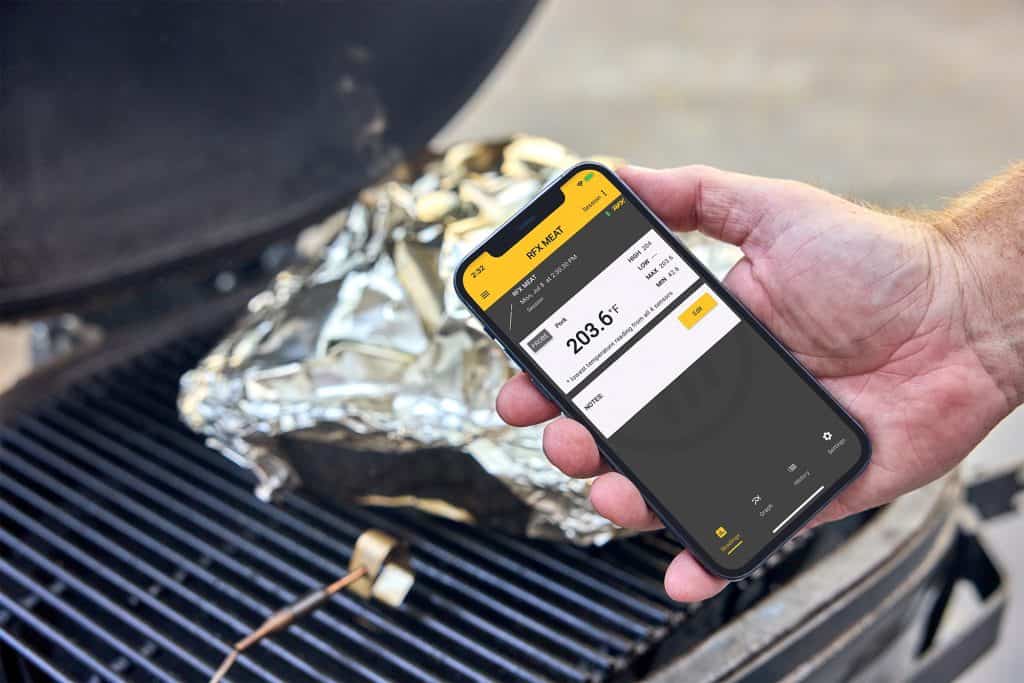
Resting and shredding the pork
When the alarm sounded in our app, we verified the temperature with our Thermapen ONE and found that we had, indeed, reached an all-over temperature of 203°F (95°C). How long had it been? About 8 hours. The last time we cooked a butt naked and slow, it took a whopping 16 hours!
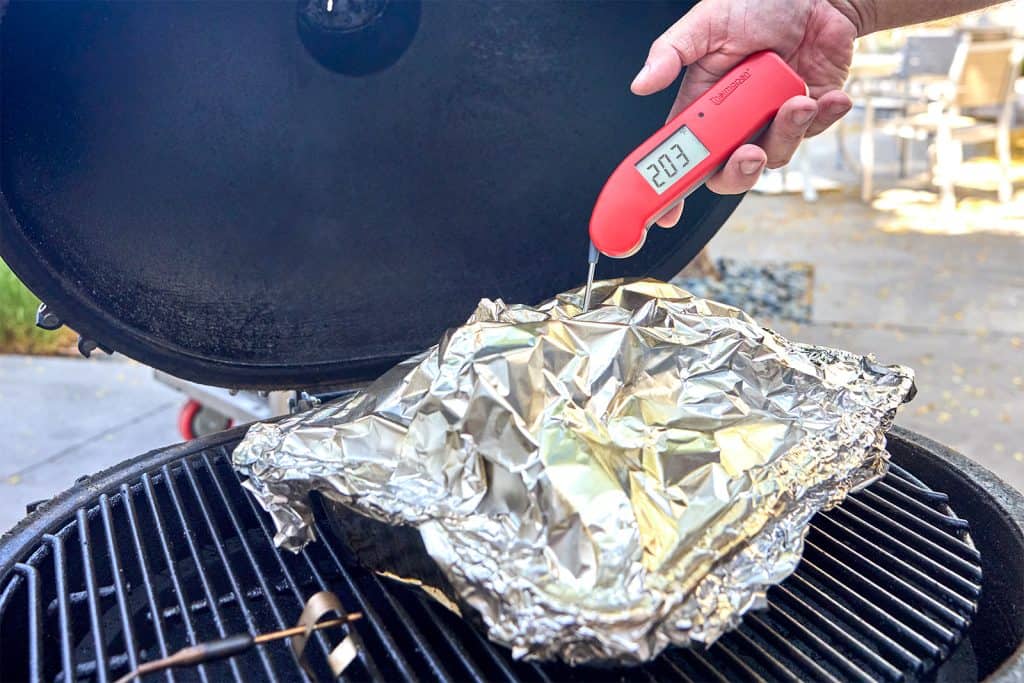
But temperature alone is not enough to ensure shreddy tenderness. Time at temperature is also important. So we left our pork in its juicy pan (now filled not only with the apple juice, butter, and Frank’s, but also with a substantial amount of rendered pork fat and captured pork juices), covered, for a couple hours. During this time, the collagen continues to melt, but the meat doesn’t get any additional heat put into it. The result is a silkier, still-moist texture at the end.
Shredding: After resting, our pork butt was ready to fall apart on its own. The blade bone fell out readily, and the meat took no effort to shred. It was beautiful. Once it was shredded up, we drizzled in the liquid contents of the foil pan, adding more rich liquid and deeper flavor to the meat. And how was it?
It was delicious.
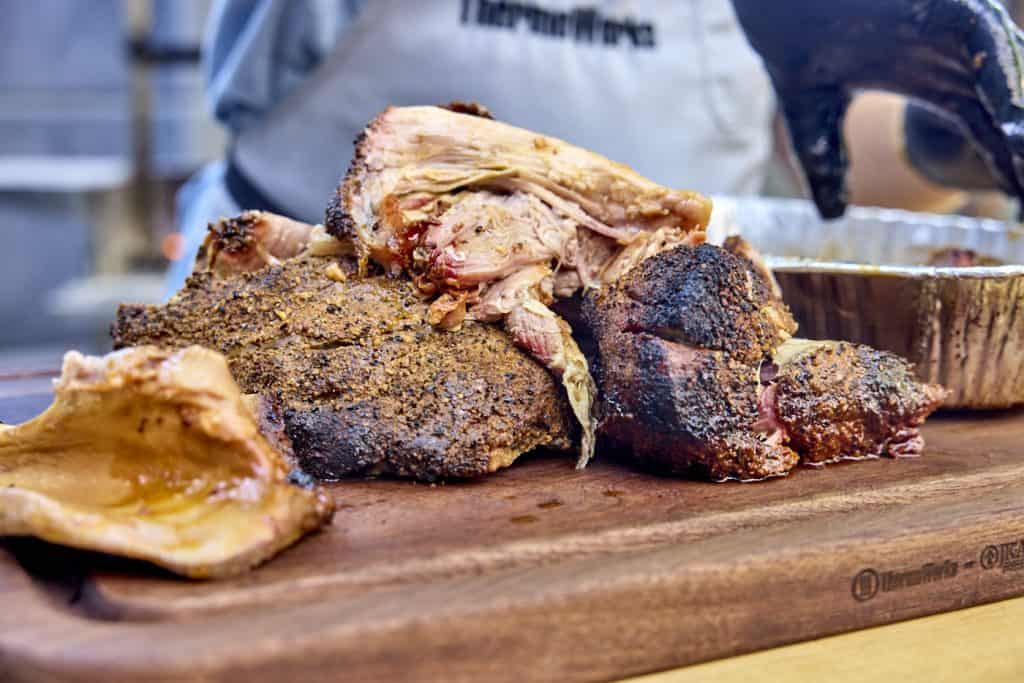
There was very little observable difference between our faster pork and a traditional low-slow version. If we had let it rest another hour, it would have been even closer to the “original” style.
Our Recommendation: The true low-and-slow smoking process certainly has its place, but for a backyard barbecue, we find the hot-and-fast process really fits the bill. Most people likely won’t detect the subtle differences in texture, and the time savings were significant. If you’re smoking your pork butt for a family reunion or other similar event, it may well be worth it to save yourself some time and crank up the heat in your smoker.
Keys to Success: Once again, here are our keys to tender and tasty pulled pork:
- Rinse and pat dry your pork butt.
- Apply your favorite dry rub.
- Preheat your smoker: 300°F (149°C) for this expedited technique. Use RFX MEAT and Billows to set and monitor the temperature of the smoker.
- Place the tip of an alarm thermometer probe (like RFX MEAT) in the center of the meat (you can easily find the cold center of the meat with an instant-read thermometer like Thermapen ONE).
- Set the internal target temp for the meat to 160°F (71°C).
- Cook until the bark sets or the high-temp alarm sounds.
- Wrap the pork when the bark is set and reset the high-temp alarm for 203°F (95°C).
- Pull your pork from heat when it reaches its target and let it rest.
- Shred, add liquid, and serve—no BBQ sauce needed!
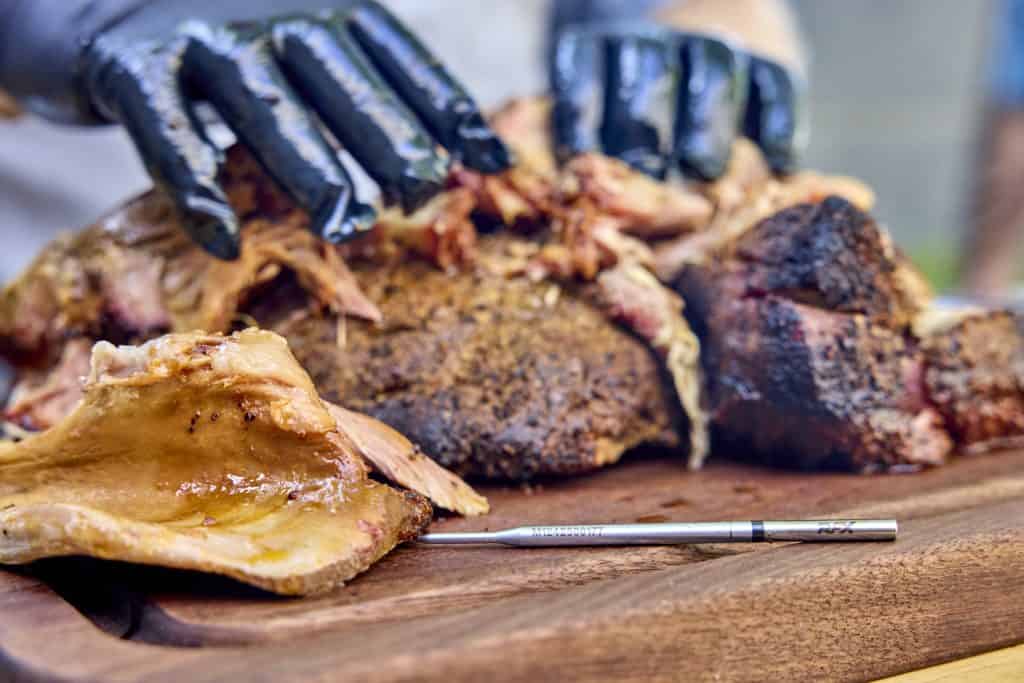
Resources:
The Food Lab, J. Kenji Lopez-Alt
Franklin Barbecue, Aaron Franklin



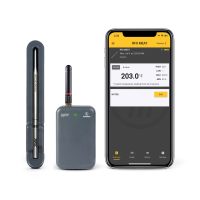
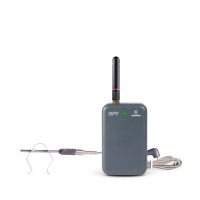
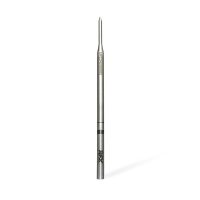
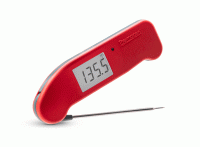
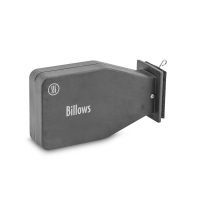
Would the same process work on Brisket, ie, 300° in lieu of 250°/225°. I’m doing one this weekend and would be interested in experimenting if you think it will work!!
Thanx
Ike,
Absolutely. Smoking a brisket is a very similar process to the pork butt. Give it a try!
-Kim
Would love to see this test done again but 225 vs 275. Many well known BBQ experts cook at 275 but 300 just seems just a bit too high as evidence shows here.
I’ve been smoking for about 20 years now. On a homemade smoker that’ll fit about 12-14 butts or 6-8 slabs of spare ribs at one time. It has the fire box at one end with about a 8″ to 10″ opening into the smoke barrel and the 4ft smokestack at the other end. Anyway enough of that business. When I’m smoking butts I’ll put’em on say 8am with the temp right at or around 300°. Around noon I’ll wrap them each in foil, rearrange them when I put’em back on to cook for at least 4 more hours. I’ve never used a thermometer to check internal temp, and don’t intend on starting. I’ve never had a butt that wasn’t done, tender and delicious. I’ve gotten and atill get great compliments on the taste, texture, tenderness and moisture of my butts. I do have to keep a close watch on the fire and Temps of the smoker, to keep it regulated at right around 300° give or take a couple of degrees. I Love smoking for not only my family but for any and everyone who needs me too. I highly recommend the temp of 300° for at least 6-8 hour, (depending in the outside temp), to which my smoker is vulnerable to. The colder it is the longer it’ll take, the hotter it is the shorter time it’ll take. Also the wind has a factor with my smoker. The faster the wind is blowing the lower my damper has to be opened. The slower the wind is blowing, the more my damper has to be opened. Thank you for letting me share my experience with you.
Thanks!
Thanks
Thanks!
Your technique is spot on. My experience is much like yours as to ideal temps and cook times. Had a commercial smoker and sold ribs and butts (pulled pork sandwiches) but now just cook for fun. The wrapping part is the best method. Always works.
Good luck to you, and thanks for your post.
D Miller, formerly of Hogs8er BBQ and Fried Pies.
Haha yeah weather definitely plays a role, its 5:30 am in MN in January and I’ve had an 8lb shoulder smoking since around 2am hope is to have it off around 3pm for football, actually a Packers fan but that’s another story. So this is where a pellet smoker with 4 dual Bluetooth Temp probes in the meat (to monitor smoking) and an ambient probe built into the smoker maintains smoker temp. Im just touching 120 internal right now with ambient set to 220 4 probes averaging about 220 reading. The wind kicked up so I think I’ll turn it up 10 deg to get it around 230 as we approach the stall, I still got almost 10 hours so I don’t think I’ll wrap it this time, we’ll see. I can only imagine how difficult a wood smoker would be in these conditions, and I’m only smoking 1 shoulder at a time… Till I master it. Carry on fellow smokers, 😉
The pork butt experiment was interesting. I have found that smoking at a cabinet temp of 205 resulted in even better results than at 225 to 230. The beast will be ready to pull at a lower meat temp. Possibly around 170. Also the cook time will be about the same if taken out at the lower meat temp. I use the fork test rather than internal meat temp. Simply insert a fork and gently twist. If it is done it will not have much resistance.
Rick,
Yes! The lower you go, and the more time the connective tissue has to render, the more tender and silky the protein will be. When you get down to those low temps around 170-200, you start getting into the realm of the reasoning behind the method of sous vide cooking. If you haven’t read up on that subject, you might be interested in it! Check out this sous vide blog post.
Thanks!
-Kim
I am a big fan of your products and have purchased many thermapens,thermoworks alarms, and many probes. I have been in the retail/ wholesale grocery industry for 47 years. I also compete in many bbq competitions.
Many bbq teams cook with smokers that are on a rotisserie as do many home cooks that have a rotisserie on a gas grill or a weber kettle.
Unfortunately you don’t have a wireless thermometer that will work in a rotisserie. In my opinion, you are missing a huge market!
I am looking forward to the day when you will come out with something that will give the home cook or competitive smoker the internal temp of the meat they are smoking/ cooking while using a rotisserie!
Bill,
So glad you’re a fan of our products! You’re correct, there really is a need for a wireless thermometer. We have a great product development team that works on tackling ideas like these. Stay on our email list to see new products as they’re released.
Thanks!
-Kim
Does your new RFX meet this requirement?
Yes it does!
An employee with Thermoworks told me she affixes a Dot to the handle of a gas grill rotisserie and allows it to rotate with the unit. Pretty cool idea!
Fascinating! With RFX MEAT, it’ll be easier…wireless probes!
Great experiment with the Butts and great write up! One thing you don’t mention in your setup is was any water pan or drip pan used above the platesetter of the Egg? Thanks and love the Therms!
I wonder how this would turn out if you reduced the smoker temp to 225F in the hot smoker when the pork temp had risen just a few degrees AFTER the stall (i.e., as soon as you can be sure you’re past the stall)? This would give this pork a little more time in the tenderizer zone as the pork finished cooking at a now-slower pace.
You don’t give the times from start of cooking to end of stall for each smoker, but I would guess that the pork in the hotter smoker got to the end of the stall a lot sooner than the pork in the cooler smoker.
Great question. The method of a dual temperature cook is worth another experiment!
And yes, the high temp pork butt moved through the stall much faster. The pork at the lower temperature moved at a pace of only 1 degree per hour for a few hours during the stall.
-Kim
I did a two-temp cook on my New Years pork butt. I had a 12 lb bone-in, salted overnight, then rubbed down with Meathead’s Memphis Dust, from amazingribs.com.
22″ Weber kettle with SnS, 1 quart water, going at 225. When the meat temp hit 145, I cranked it up to 275 F.
To blow through the stall. It spiked a couple times to 280-290 F. At internal meat temp of 170, I brought it back down to 225 for the remainder of the cook. Pulled at 201F internal temp.
The results: done in 10.5 hours. Excellent bark, and I hardly needed the bear paws to shred it. Devoured with high praise from all of my guests. In my estimation, it was not quite as good as a complete low and slow, but still very good. Most of the meat was very moist and silky, with some drier spots. In my case, getting a late start, and having dinner guests, it was worth the compromise. If time permits, I will still go for the complete low and slow.
I have tried cooking butts both ways, “low and slow”, and “turbo”. we still prefer the low and slow method for taste and texture.
What was the weight of the butts when you started the cook?
This was an excellent article– love the experimental “science” articles. The explanation of the plateau made so much sense. I Think I’ll split the difference and keep on cookin.
As an aside you used the term “..Fire craft”. That is the reason I bought a pellet grill and I’m so happy I’m short on fire craft!!!
I agree. I purchased a pellet smoker a few years ago, and have been very happy with it! I have digital readouts for smoker temp, and meat temp. I am still learning so, I am happy to not have to perfect my “firecraft”. Cook temp varies +- 7-10 degrees, making it easier to get it right!
You may find that the bone in butts cook faster, likely due to the bone bringing heat into he center of the butt. New blog subject???
You can cook it at 800 degrees but it want be the same as low and slow. The moral to the story– low and slow always delivers the best product. Buy a BGE and for precision temperature control, a Stoker. Set it up and come back 16 hours. Buy the BB with the blade bone which helps the internal temp come up, and when bone is loose and comes out easily, it’s done.
Finally, an explanation of “the stall” that makes sense. Thanks…
I’ve smoked several pork butts & read many recipes, but I’ve Never read one that instructed the butt to be cooked ‘fat side down’. Every one that I’ve read, except yours, says to place the butt ‘fat side up’, so the fat melts through the butt. Did you really cook it fat side down or was that a typo ??
No, because it can’t melt through the butt at all for any reason. Melts around maybe but through?? Nope, science says that’s bs
You want the fat cap down as to protect the meat. That concept of the fat melting and making the meat moist just is not true. Protect the meat and do the fat cap down, and don’t trim it.
Excellent article.
I did not know about “the stall” or using paper to wrap at rest before shredding.
Thanks very much,
Mike
I will try this; your article is a very good read.
Steve,
Thank you for the excellent question, and no, it wasn’t a typo. We placed the meat on grate surface fat side down. There are two schools of thought with this: fat side up and fat side down. The thought with fat side up is that the rendered fat will absorb as it travels down from the top. With fat side down the thought it that the fat will insulate the meat from the direct heat, and avoid drip loss from the rendered fat during the cook. Both methods are for similar reasons-to maximize juiciness in the meat. Give fat side down a try and see what you think!
-Kim
I belive the issue is how you are cooking the meat. if completely indirect ie gas grill then fat side up makes sense. if cooking on wood charcoal then fat side down. just my opinion!
Travis,
Definitely a new blog possibility! That’s one aspect of these projects that’s so great–we always end up with more questions to explore.
-Kim
Chris,
Each was about 8 to 8-1/2 lbs.
-Kim
Rick,
Absolutely. You really can tell a difference in the texture–it’s worth the extra planning!
-Kim
Adam,
Yes, a water pan was used in the smoker. Thank you for picking up on details we miss!
-Kim
I did a two-temp cook on my New Years pork butt. I had a 12 lb bone-in, salted overnight, then rubbed down with Meathead’s Memphis Dust, from amazingribs.com.
22″ Weber kettle with SnS, 1 quart water, going at 225. When the meat temp hit 145, I cranked it up to 275 F.
To blow through the stall. It spiked a couple times to 280-290 F. At internal meat temp of 170, I brought it back down to 225 for the remainder of the cook. Pulled at 201F internal temp.
The results: done in 10.5 hours. Excellent bark, and I hardly needed the bear paws to shred it. Devoured with high praise from all of my guests. In my estimation, it was not quite as good as a complete low and slow, but still very good. Most of the meat was very moist and silky, with some drier spots. In my case, getting a late start, and having dinner guests, it was worth the compromise. If time permits, I will still go for the complete low and slow.
Joseph,
Thank you for the detailed information–it’s so interesting to hear how a cook like this goes for others. No wrapping through the stall, just increased temperature? And we felt the same way, that the faster cook was good, but the lower temperature cook had a more tender, silky texture. Stay subscribed to emails, we have some fun projects coming up this year. Happy cooking!
-Kim
Maybe I missed it but what were the weights of the Butts?
John,
They were each about 8 pounds. Thanks!
-Kim
The most important step to ensuring the meat stays moist, is to WRAP WITH FOIL and LET REST for an hour!
If you jump the gun, and shred it while still hot, you will let all that moisture evaporate =(
Another great moistness tip, is to periodically spritz with a sprayer filled with Apple juice. A beautiful ‘bark’ can be attained by spraying/hitting with rub/let the heat and smoke melt it in…repeat as necessary
I’ve been cooking a 4.25 lb Boston butt for over 20 hours now at 225°, and the temp does NOT want to get past 186°. It’s been fluctuating between 185 and 186 for over 2 hours now. Ever heard of anything like this? I already experienced “the stall” between 145ish and 160 or so, so a 2nd stall?? And over 20 hours for this small of one??
Mike,
I was out of office yesterday, so I’m sorry I didn’t see your comment. I’ve never heard of a butt taking that long, no matter the size! I can’t think of what might be going on, unles sit was very nearly (or literally) frozen in the center. But, if this (somehow?!?) ever happens again, you can pull it anyhow. Collagen melt is a function of temperature AND time, so even though it didn’t get up to, say, 203°F, after an hour or two at 185°F it should be quite tender and delicious.
The 20 hrs could be from altitude. Might not ever to the higher temps due to lower evaporation.
In Alabama, mostly in the Birmingham area, cooking butts over hot coals that was open the meat was done in 6-7 hours if I remember right. These high temperatures created an outstanding flavor.
In those days, when you ordered your meat, you ordered outside, inside, or both. The sign of an outstanding BBQ resturant.
That’s cool!
I am starting a 9 lb butt in the morning to smoke low and slow (225-250, offset, away from coals) to absorb mesquite flavor, up to 260 internal, on my grill with charcoal & mesquite, perhaps 8 hours, then wrap two layers heavy duty foil, then finish in the oven, in a large broiler pan indoors.